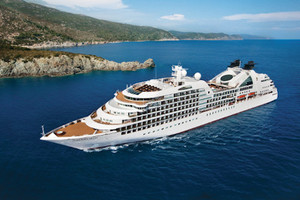
It’s early in the morning, and I’m standing beside a taco stand about to bite into one-dollar taco de cabeza. Known as a head taco, it consists of soft corn tortilla, and as our guide, Juan Carlos, explains, it’s filled with beans and various steamed bits of a cow’s head. For a fleeting moment, I can’t help but think of Old El Paso; not the place of Texas legend, but the brand of Mexican food you buy at the supermarket. In its world, tacos are bright yellow hard shells like corn chips, which you fill with a chilli mostly made from minced beef. In this small enclave nestling in the foothills of the Sierra Madre - the real Mexico - these tasty pancakes are quite different. A staple part of the local diet, and taken very seriously, they are also way more tasty than their mass market counterparts. Eating tacos in a small mountain town isn’t normally how I start a Wednesday morning, and it’s also a world away from our cruise ship, which is just half an hour away docked in Puerto Vallarta. After a two-night stay at the Queen Mary Hotel in Long Beach, we’d swapped a bed on an iconic and historic ocean liner of days gone by, for one on a modern cruise ship. And only three days into a seven-night cruise of the sparkling Mexican Riviera, we had a sense this was going to be a cruise with a difference. The itinerary is a primary reason for taking one of these cruises.
Puerto Vallarta
The first of our three ports of call was Puerto Vallarta, a picturesque coastal resort nestling on Banderas Bay, and framed by the mountains of the Sierra Madre. It’s a destination rich in tradition and boasting the heart and charm of a small Mexican town. As a new destination for us, we ignored the call of the beach to head for the hills on a tour of the Sierra Madre, taken in an all-purpose Mercedes-Benz postwar vehicle called a Unimog. Our day-long sortie began with tacos in the small town of San José, and went on to include a scenic hike in the Sierra Madre forest with a visit to a real mountain home. It finished with a relaxing beach barbecue and much-needed swim to cool off from the heat, and wash off some of the sunscreen and bug spray.
Mazatlán
The next day we pulled into the locally dubbed “Pearl of the Pacific”, also known as Mazatlán. A place blessed with perpetual summer, it’s more of a traditional port city than a resort per se, situated just below the Tropic of Cancer and marking the beginning of the Mexican tropics. Our objective here was to combine hitting the beach with savouring some of the area’s natural beauty, so we chose a half-day eco-tour to Isla de Venados, or Deer Island. One of Mazatlán’s coastal islands, and just a 45-minute cruise by catamaran away, it’s part of a natural reserve which includes all 900-plus islands of the Sea of Cortez and a UNESCO World Heritage Site. A highlight was undoubtedly the guided hike along a path flanked by amazing cactus trees, which wound its way up a hill to reveal stunning views of the ocean, the cliffs and Mazatlán.
Cabo San Lucas
Our final stop before heading back to Long Beach was a half-day stay in Cabo San Lucas, a vibrant playground at the southern tip of the Baja peninsula where the Pacific Ocean and the Sea of Cortez meet. It’s a bustling hive of activity and adventure even at the quietest of times, and the place to rent a jet ski or go parasailing, or take a trip out to view its famous rock formations, Los Arcos. As repeat visitors, however, for us, it marked a long awaited return to a favourite hideaway, the stunning Playa Del Amor or Lover’s Beach. Although it has evidently become a victim of its own popularity in recent years, and is definitely more built-up than it used to be, it remains one of the more quiet spots close Cabo where you can still get away from it all - just a bit.
Side Trips
There are a number to choose from, and for anyone who loves a good theme park, top of the list is the world-famous Disneyland Resort. The best way to get there is to self-drive, and there are plenty of premium and luxury accommodations to choose from in the resort and the surrounding area if you wish to stay overnight. A variety of holiday packages and ticket options are available.
An adult alternative is “doing” Vegas, the former frontier town which was transformed in 1931 when gambling was legalised. Today it’s a haven of entertainment and indulgence, with themed hotels, shopping, nightlife, restaurants and, of course, casinos. You can fly, take a Greyhound bus if you’re really feeling adventurous, or you self-drive in around five hours. Accommodation options abound from the hotels of the famous Strip, to apartment hotels for longer stays. For more information, visit www.visitlasvegas.com.au
Must-Do Things On Mexico’s Riviera Coast
Go horse riding: a unique way to experience the scenery of Cabo San Lucas is on a guided beach horse ride. Rides are available for all ages and abilities.
Take an ATV tour: it’s a fun-packed way to escape Cabo’s crowds, and explore Baja California’s kilometres of sweeping sand dunes.
Go surfing: north of Puerto Vallarta, beyond Bucerias, there’s a slew of options from zippy little reefs to fun beach breaks, and the water is gloriously warm.
Visit Las Calettas: nestled in a secluded private reserve on the southern shores of Puerto Vallarta, it’s an exquisite tropical beach escape accessible only by boat.
Go fishing: Mazatlán is famous for deep sea sport fishing, and on any given day you can encounter tuna, marlin, sailfish, dorado and swordfish.
- By:
- Joanna Hall
Reviews
-
Is It Safe?
You hear so much bad press about Mexico these days, is it really safe to cruise there? Always been curious as it looks like fun but I don't want to be at risk.












